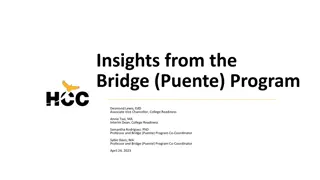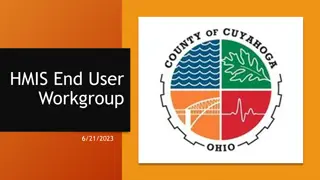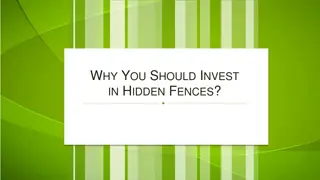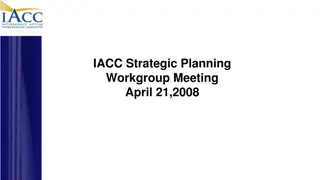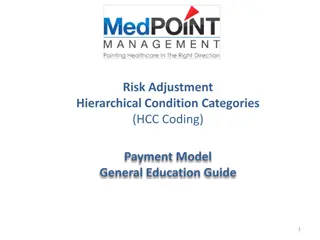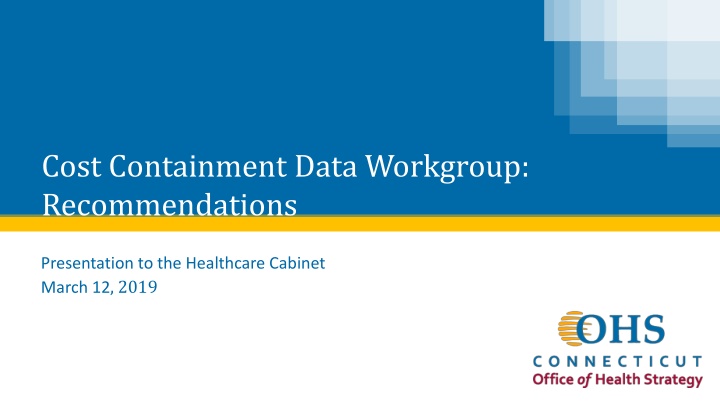
Healthcare Cabinet Recommendations for Cost Containment Strategies
The presentation outlines recommendations from the Cost Containment Data Workgroup to the Healthcare Cabinet, focusing on strategies to control healthcare costs in Connecticut. It includes discussions on background, process, areas of interest, data availability, feasibility, and prioritization criteria. The workgroup members, process steps, and top-tier measures of cost are also highlighted.
Download Presentation

Please find below an Image/Link to download the presentation.
The content on the website is provided AS IS for your information and personal use only. It may not be sold, licensed, or shared on other websites without obtaining consent from the author. If you encounter any issues during the download, it is possible that the publisher has removed the file from their server.
You are allowed to download the files provided on this website for personal or commercial use, subject to the condition that they are used lawfully. All files are the property of their respective owners.
The content on the website is provided AS IS for your information and personal use only. It may not be sold, licensed, or shared on other websites without obtaining consent from the author.
E N D
Presentation Transcript
Cost Containment Data Workgroup: Recommendations Presentation to the Healthcare Cabinet March 12, 2019
Presentation Areas of Discussion Background Process Areas of Interest Selection and Prioritization Criteria Data Availability and Feasibility Recommendations Discussion and approval 2
Healthcare Cabinet - Background Public Act Number 15-146, Section 17 Recommended Health Care Cost Containment Strategies: Healthcare Cabinet Report Transform the delivery and payment systems; Directly reduce cost growth; Coordinate and align state strategies; Support market competition; Support provider transformation; Support policymakers with data; and Incorporate use of evidence-based research into state policy making Healthcare Cabinet s June 12, 2018 Meeting Commissioned workgroup to review data resources to support cost containment initiatives 3
Cost Containment Data Workgroup Members Susan Adams (Masonicare) Ellen Andrews (Connecticut Health Policy Project) Pat Baker (Connecticut Health Foundation) Ted Doolittle (Office of the Healthcare Advocate) Kelly Sinko (Office of Policy and Management) Shelly Sweatt (TR Paul Inc.) Victoria Veltri (Office of Health Strategy) Josh Wojcik (Office of the State Comptroller) Support provided by: Allan Hackney, HITO, OHS Rob Blundo, Access Health CT CedarBridge Group, LLC 4
Process Identify top-tier measures of cost Identify costs by category Identify specific areas of concern Assess data availability and feasibility first pass Prioritize areas of concern Assess data availability and feasibility second pass Identify policy/program opportunities 5
Top Tier Measures of Cost Total costs of healthcare provided to residents of Connecticut Per capita costs (per member, per month) Trends in total costs of healthcare over time Total all-in costs to the consumer, including out-of-pocket expenses, premium contributions, copays, and deductibles Total cost and per capita costs, including trends over time, broken down by payer type (e.g., commercial, Medicare, Medicaid, and the state employee health plan) 6
Cost by Category Total cost of care distribution by category of care (e.g., hospital, providers, prescription drugs, etc.) and payer type (e.g., commercial, Medicare, Medicaid, and the state employee health plan) Comparisons of costs for similar patient populations, broken down by providers and health systems Total cost of care distribution by diagnosis Total cost of care distribution by race, ethnicity and language Variations in utilization by diagnosis and outcome Incidence of cost and utilization outliers, both high and low outliers Total and per capita administrative costs, including expenditures for quality improvement activities Emergency department visits for behavioral health (by payer) Impact of waste on total healthcare costs, using industry-accepted definitions of waste 7
Specific Areas of Concern (1 of 2) Out-of-pocket cost burden for the consumer and trends over time Ability to track price and utilization variations Before and after a merger/consolidation, both vertical or horizontal By geographic area By size of health system and/or practice By quality of care By volume By category or setting of care, such as hospitals and health systems, community health centers, provider groups, and urgent care centers High-risk, high-cost populations Trends over time Tracking whether high-risk, high cost patients persist over time or are episodic By payer type (including Worker s Comp when available) Primary care costs, utilization and total cost of care before and after hospital primary care conversion to community health centers Impact of cost of new drugs, procedures, and devices Over-utilization and under-utilization of services 8
Specific Areas of Concern (2 of 2) Cost-shifting from one covered population to another Impact on healthcare cost resulting from transitioning to and from Medicaid Impact on quality and cost of movement to value-based care and provider risk Readmission rates and costs Costs and predictors of preventable hospitalizations and emergency department visits Price and utilization of resources for patients seen by primary care physicians vs. specialists Utilization of home care services and impact of home care agency closures and rate cuts Impact of facility fee notification Total costs of waste, using industry-accepted definitions Relative drivers of cost over time, including pricing, utilization, and enrollment 9
Operating Principles Prioritization Criteria 1. Commitment to Impact: Contribute to the improved physical, behavioral, and oral health of all Connecticut residents as seen in the following: The number of individuals and/or constituencies affected The depth and/or intensity of the problem Reduction of barriers and burdens for those most vulnerable The time frame in which change can occur The cost effectiveness of health and health care purchasing that promotes value and optimal health outcomes A health insurance marketplace that provides consumers a competitive choice of affordable and quality options 2. Equity in Health Care Delivery and Access: Recommendations incorporate the goal of reducing disparities based on race, ethnicity, gender, and sexual orientation. 3. Leverage: Recommendations must: Make the best use of past and current knowledge and expertise Maximize the opportunities provided through initiatives from the public and private sector Be informed by data and evidence-based practice and research Be sustainable 4. Accountability and Transparency: Be fully accountable to the public in a transparent process that meets the objectives of PA 11-58. Identify and measure outcomes that demonstrate meaningful results Maintain consumer-driven goals throughout the process 5. Inclusion: Ensure that there are meaningful opportunities to obtain a broad cross-section of views from all stakeholders, including consumers, communities, small business, payers, providers, and government. 6. Action: All recommendations must take into account implementation and position of Connecticut to seize 10 opportunities.
11 Priorities
Data Availability and Feasibility Note Level of Effort may be adjusted as categories become more precisely defined. 12 12
15 DISCUSSION

